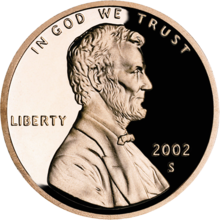
A debate exists within the United States government and American society at large over whether the one-cent coin, the penny, should be eliminated as a unit of currency in the United States. The penny costs more to produce than the one cent it is worth, meaning the seigniorage is negative – the government loses money on every penny that is created. Several bills introduced in the U.S. Congress would have ceased production of pennies, but none have been approved. Such bills would leave the five-cent coin, or nickel, as the lowest-value coin minted in the United States.
Other countries have also withdrawn coins no longer worth producing, such as Canada ending production of the Canadian penny in 2012. The most recent time that the United States withdrew the lowest-value coin from circulation was with the half-cent coin (hay-penny), which was withdrawn in 1857; the 1857 half-cent coin was worth approximately 16 cents in 2023 dollars.[1][a]
- ^ 1634–1699: McCusker, J. J. (1997). How Much Is That in Real Money? A Historical Price Index for Use as a Deflator of Money Values in the Economy of the United States: Addenda et Corrigenda (PDF). American Antiquarian Society. 1700–1799: McCusker, J. J. (1992). How Much Is That in Real Money? A Historical Price Index for Use as a Deflator of Money Values in the Economy of the United States (PDF). American Antiquarian Society. 1800–present: Federal Reserve Bank of Minneapolis. "Consumer Price Index (estimate) 1800–". Retrieved February 29, 2024.
Cite error: There are <ref group=lower-alpha> tags or {{efn}} templates on this page, but the references will not show without a {{reflist|group=lower-alpha}} template or {{notelist}} template (see the help page).
© MMXXIII Rich X Search. We shall prevail. All rights reserved. Rich X Search
